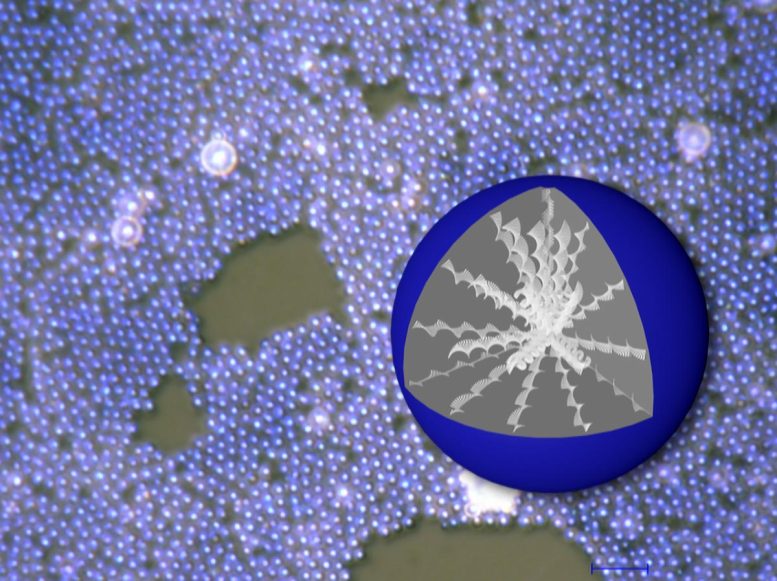
Cholesteric liquid crystals (CLCs) display unusual colors due to their unique molecular structure and optical properties that lead to the selective reflection of light at specific wavelengths. Credit: Yukikazu Takeoka and Jialei He
Scientists have developed a method to create unique anti-counterfeiting QR codes using micrometer-sized spherical cholesteric liquid crystals (CLCs), paving the way for more secure, unreplicable QR codes.
Revolutionizing Anti-counterfeiting: QR Codes Based on Cholesteric Liquid Crystals
A research group led by Dr. Jialei He from Nagoya University’s Graduate School of Engineering has developed a method for processing cholesteric liquid crystals (CLCs) into micrometer-sized spherical particles. CLCs, which exhibit a helical structure, possess unique optical properties, and they can selectively reflect light. The team combined spherical CLC particles with readily available pigments to develop an anti-counterfeiting QR code that is only visible under a specific circular polarizer. The study’s findings were published on July 9 in the journal Advanced Optical Materials.
Harnessing the Power of Nature in Engineering
Cholesteric liquid crystals serve as an example of how we can draw inspiration from nature for engineering purposes. The iridescent wings of butterflies or the glossy coating on beetle exoskeletons are examples of the extraordinary phenomena CLCs can generate. Once identified, CLCs that mimic the units that generate the colors of the exoskeletons of beetles are synthesized in the laboratory because of their unusual colors and properties, which lie between liquids and crystals.
Optical Properties of Cholesteric Liquid Crystals
The optical properties of CLCs are particularly beneficial. Their unique molecular structure and optical properties allow for the selective reflection of light at specific wavelengths, resulting in unusual colors. CLCs consist of long molecules that repeat themselves in the shape of a helix. In this helix, the vertical distance at which one region completes a full loop and starts repeating itself is known as the ‘pitch’. If the helix has repeating units that are close together, the liquid crystal has a short pitch and reflects shorter wavelengths of light, giving off blue and violet colors. However, those with a longer vertical space have longer wavelengths, leading to red or orange colors.
Moreover, due to the helical arrangement of molecules in the crystal, the perceived color can change based on the viewer’s orientation to the helix, offering an almost infinite palette of colors.
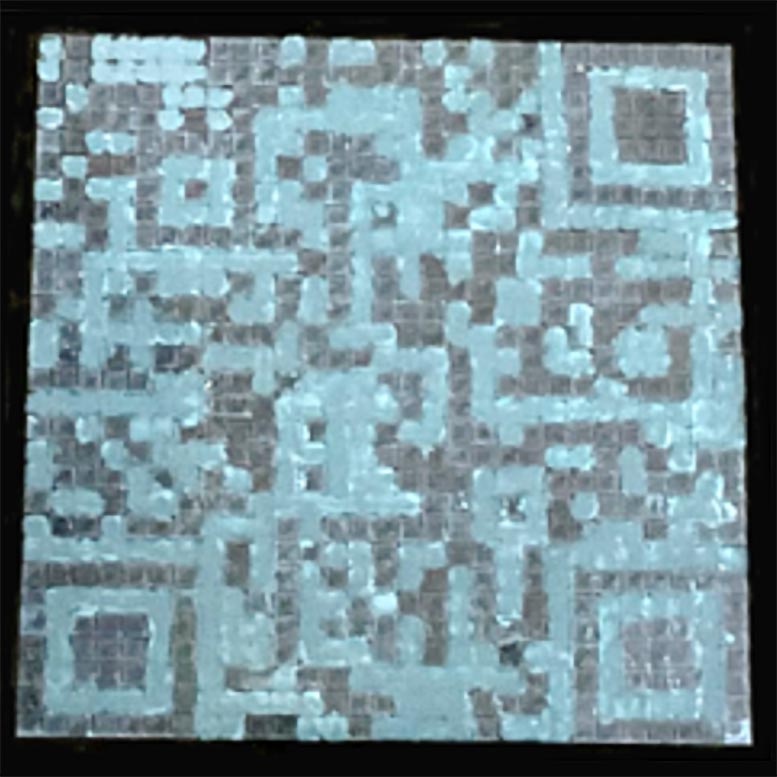
One potential application for this research is the creation of more secure QR codes that cannot be replicated. Credit: Yukikazu Takeoka and Jialei He
Creating Spherical CLC Particles
To exploit CLCs more effectively, researchers produce spherical CLC particles. These particles encapsulate the helix in a 3D matrix, giving scientists improved control over their coloration. However, size poses a significant issue. Existing methods create 100-micrometer spherical CLC particles, which are too large for most applications. To address this, researchers Jialei He and Yukikazu Takeoka from Nagoya University, along with their colleagues, used a mixture of solvents to create micrometer-sized spherical CLC particles using a technique known as dispersion polymerization.
Finding this new technique was challenging due to the soft nature of the samples at room temperature. “The sample testing was a particularly challenging time due to the softness of the samples at room temperature, which is a property inherent to CLCs,” said Dr. He. “Consequently, a considerable amount of effort was required to find an appropriate method to characterize the samples without causing any damage.”
Creation of Monodisperse Spheres
Since the pitch of the cholesteric liquid crystal in spherical CLC particles varies with the particles’ curvature, the team focused on producing particles of uniform size, also known as monodisperse spheres.
“During the experiment, we unexpectedly discovered that the particle size of the microspheres significantly influenced the resulting structural color. We could produce a variety of colors depending on particle size,” said Dr. He. “We also found that covering the spherical CLC particles with the polymer polydimethylsiloxane improved the coloration and thermal stability.”
Anti-Counterfeiting Applications and Future Prospects
A key potential application for this research is the creation of more secure, unreplicable QR codes. By harnessing the chirality of CLCs—an asymmetrical property that prevents an object or molecule from being superimposed onto its mirror image—researchers could create anti-counterfeiting QR codes. These codes would combine the color of spherical CLC particles with non-chiral, commercially available pigments, and could only be read with a specific circular polarizer that permits non-chiral light but blocks the chiral light of the QR code.
“The development of spherical CLC particles development resulting from this research will provide new possibilities for low-cost structural color functions different from those of conventional color materials,” said Dr. Takeoka. “As well as being used as a special functional pigment for anti-counterfeiting, it can also be used for other applications that take advantage of the circularly polarized structural color with little angle dependence.”
Reference: “Particle Size Controlled Chiral Structural Color of Monodisperse Cholesteric Liquid Crystals Particles” by Jialei He, Sizhe Liu, Guohao Gao, Miki Sakai, Mitsuo Hara, Yuto Nakamura, Hideo Kishida, Takahiro Seki and Yukikazu Takeoka, 9 July 2023, Advanced Optical Materials.
DOI: 10.1002/adom.202300296

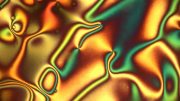
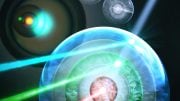
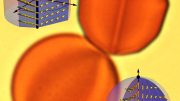
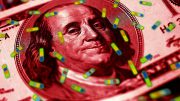
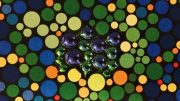
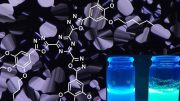
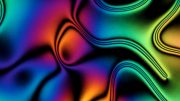
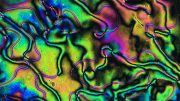
Be the first to comment on "Holographic Beetles and Liquid Crystals: The Science of Ultra-Secure QR Codes"